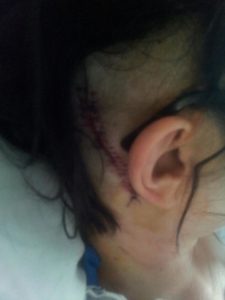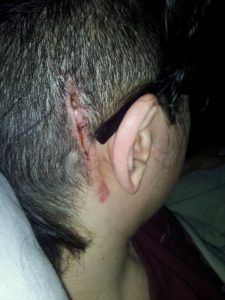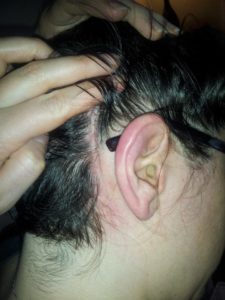This is a guest post by a patient, Nikki Thelan. Please read her story of recovery and return to a full healthy, active life after an amazing year of hardship. I am so priviledged that Nikki came into my life last winter because sharing in this journey has been truly inspirational. She is one powerful, determined woman!
I must have heard him wrong. “I’m sorry, did you say I have a brain tumor?” I was sure my ENT had called the wrong patient. I was awaiting the results of a MRI of my head. The events of the summer of 2012 had led up to this day in September. A once sluggish and overweight woman, I had lost 100 pounds in the previous two years and had become a runner. But suddenly, I wasn’t feeling well. I couldn’t put my finger on exactly what I felt but I knew something was off. I had constant headaches and was tired and lethargic all the time. The most worrisome symptoms, though, were diminished cognitive abilities and constant dizziness. The vertigo would hit me suddenly, even when sitting still, and would end with nausea. I had not shared any of this with anyone. I, like many people, like to live in a world of denial when it comes to my health. I didn’t utter a word to anyone. Denial is a warm, soft blanket until you share it with someone else. My fuzzy blanket had just unceremoniously been tossed into an epic fire.
While I had finally decided to face reality and met first with my PCP and then eventually an ENT, I joked and made light of my symptoms. When the ENT ordered the MRI I went home to my boyfriend and laughingly told him that it was probably a tumor and I had already named it Bob. My pathetic attempt at humor had just bitten me in the butt. 34 years old and diagnosed with a brain tumor.
After doing my own research and consulting with a neurosurgeon at Massachusetts General Hospital I elected to have a craniotomy. Patients with my kind of tumor (Acoustin Neuroma) have three options: Surgery, radiation or watch and wait. Dr. Barker said that radiation was not something his team would perform on someone my age and I was happy to hear that because….radiation? On my brain? I’ll pass, thank you very much. Yet, I also wasn’t willing to wait and watch Bob grow. Bob was an unwelcome tenant in my brain. I wanted my life back and Bob needed to be evicted. We scheduled a craniotomy for November 2nd, Bob’s D-Day.
I returned home 4 days after my surgery and began my lengthy recovery process. I had no balance, as my vestibular nerve, which controls balance, had been severed during surgery. My first 4 weeks at home are a blur due to pain meds. I spent a lot of time sleeping or resting on the couch. I watched the clock so that I could take more pain meds. It’s hard to describe the pain in my head but imagine a Doozer (a la Fraggle Rock), a miner setting up shop in your head. And that little tiny miner is tapping on your skull with a hammer. Over and over again. It never stops. The pain started behind my right eye and radiated up over the right side of my forehead and down along my head. It was nearly constant. I often had to find a position to rest in and not move. I was sent to the ER at one point because I was in so much agony. My doctors assured me all this was normal. After 4 weeks, they took away my pain killers and suggested ibuprofen. Ibuprofen did little to nothing to subdue the pain.
Pain and discomfort became my constant companion. Most of the pain revolved around and in my incision site. The incision began just below my hairline behind my ear and rose about 4 inches up the side of my head. The resulting scar was an inflamed and angry red. The skin was so sensitive all around the incision that I couldn’t touch my skin or hair on that side. I was unable to bend over and move quickly because this resulted in intense pain and dizziness. I was unable to turn my head to the right because my neck muscles pulled on everything along the side of my head and caused the most amazing jolt of pain. I moved much like a robot with very planned, stiff motions. This movement of my body eventually became natural to me and I would just turn my entire body in the direction I needed to see. Then there was the actual pain. The minute I opened my eyes in the morning I was hit with a wave of pain. I would slowly rise from bed and make my way to the recliner. There I would settle in and adjust my neck and head until I found that sweet spot where the pain stopped for a second. Then I would freeze in that position and wait for about an hour for everything to stop hurting. It seemed that it was always about waiting for the pain to stop. The number one priority in my life was trying to manage the pain.
 I returned to work 9 weeks post-surgery. I thought I was ready. Maybe work would distract me. I wasn’t ready. Did I mention I lost hearing in my right ear during surgery? Not only did I have to deal with the pain from surgery, but now I had to struggle with this new idea of SSD (single-sided deafness). The true kicker about my SSD is that while I cannot hear from my right ear I am blessed to have tinnitus. I have the pleasure of listening to the Emergency Broadcast alarm 24 hours a day. At home it wasn’t so hard and I had become accustomed to the loss of hearing in my quieter environment. But returning to work I now had to deal with ringing phones, my staff all talking to me at once, and the general noise of a busy work environment. Between the pain, confusion and misery I sunk into a place of depression.
I returned to work 9 weeks post-surgery. I thought I was ready. Maybe work would distract me. I wasn’t ready. Did I mention I lost hearing in my right ear during surgery? Not only did I have to deal with the pain from surgery, but now I had to struggle with this new idea of SSD (single-sided deafness). The true kicker about my SSD is that while I cannot hear from my right ear I am blessed to have tinnitus. I have the pleasure of listening to the Emergency Broadcast alarm 24 hours a day. At home it wasn’t so hard and I had become accustomed to the loss of hearing in my quieter environment. But returning to work I now had to deal with ringing phones, my staff all talking to me at once, and the general noise of a busy work environment. Between the pain, confusion and misery I sunk into a place of depression.
That’s the funny thing about a major illness: Despite all the amazing support one might have, it’s an incredibly lonely journey. I was surrounded by uplifting support in the days leading up to my surgery and the weeks after. But as I began to become more independent the people in my life moved on. I, however, felt frozen in time. Bob may have moved out, but he was still a presence in my life.
My defenses came down in my therapist’s office one day. I admitted and revealed that I was at the darkest point of depression, the darkest I had experienced in many years. Something had to give. I couldn’t accept that this was the standard of my new life. I wanted to run again. I wanted to smile and feel like my old self. It was at that point that she told me I needed to take charge of my recovery. She suggested acupuncture.
Enter one Courtney Wulsin, acupuncturist extraordinaire. I was, admittedly, suspicious of acupuncture. Could it really work for me? I had a consult with Courtney and I immediately felt…comforted. Here was someone that cared about my condition and my pain. I realized later that what I needed most was nurturing and compassion. Courtney offered that to me and so much more: A journey to finding some peace. She spent an hour with me, listening and taking notes. We made a plan and I felt hopeful. I left her office and cried in my car. For the first time since my initial diagnosis I felt relieved and hopeful for something better.
 Acupuncture hasn’t always been a painless experience. However, I firmly believe that sometimes you have to push yourself to get what you need from an experience. When Courtney said she wanted to do some needle work around my incision site I sincerely thought she was crazy. Perhaps I was crazier for saying, “sure, let’s go for it.” I was going to be tough and I was going to do whatever Courtney recommended. How badly did I want to get better? Badly enough that I allowed her to begin putting tiny needles around the most sensitive and painful point on my body. I took deep breaths, listened to her soothing voice and went with it. I wanted to heal.
Acupuncture hasn’t always been a painless experience. However, I firmly believe that sometimes you have to push yourself to get what you need from an experience. When Courtney said she wanted to do some needle work around my incision site I sincerely thought she was crazy. Perhaps I was crazier for saying, “sure, let’s go for it.” I was going to be tough and I was going to do whatever Courtney recommended. How badly did I want to get better? Badly enough that I allowed her to begin putting tiny needles around the most sensitive and painful point on my body. I took deep breaths, listened to her soothing voice and went with it. I wanted to heal.
I have done so much healing in my many months seeing Courtney. I’ve healed physically. I’m no longer chewing ibuprofen every 4 hours like it’s candy. My pain levels are, most days, non-existent. I still experience pain, but it’s minimal compared to where I was when I began to see Courtney in February of this year. I’ve also healed emotionally. Courtney taught me to allow myself to acknowledge what I’m feeling and to embrace the emotions. I recently experienced the terrible loss of a beloved pet. I visited Courtney just a few short days after saying goodbye to him and expressed my overwhelming sorrow. As she placed the needles along my body she told me to feel whatever I needed to feel. As I laid on that table, tears leaked from my eyes. I didn’t sob but rather, my tears flowed. I felt my pain and sorrow and embraced it. Later, Courtney sent me an email with these profound words: Be kind to yourself.
This experience taught me many lessons. I’ve learned to accept help. I’ve learned I am more loved and cared for than I ever knew or was willing to acknowledge. I’ve learned life is worth living but sometimes you have to do hard work. I’ve learned I am important and worth compassion and nurturing. I’ve learned to be kind to myself. I never expected to go through this journey. Yet, Bob was probably the best thing to ever happen to me.
I woke up this morning, on this crisp fall day, and felt a twinge of pain along the side of my head. I took my prescribed herbs, brewed my tea, and watched the leaves fall. I felt my pain, acknowledged it and took some deep breaths. No need to hurry. I will be kind to myself. We should all be kind to ourselves.
By: Nikki Thelan
- Picture One: Day After Surgery
- Picture Two: Two Weeks Post Surgery
- Picture Three: Post Acupuncture